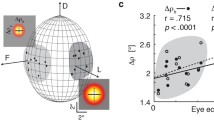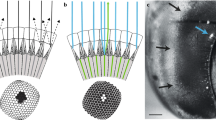Summary
The fine structure of the cornea in an anatomically and functionally specialized part of the honey bee's compound eye (dorsal rim area) was examined by light microscopy, transmission electron and scanning electron microscopy. Under incident illumination the cornea appears grey and cloudy, leaving only the centers of the corneal lenses clear. This is due to numerous pore canals that penetrate the cornea from the inside, ending a few μm below the outer surface. They consist of (1) a small cylindrical cellular evagination of a pigment cell (proximal), and (2) a rugged-walled, pinetree-shaped extracellular part (distal). The functional significance of these pore canals is discussed. It is concluded that their light scattering properties cause the wide visual fields of the photoreceptor cells measured electrophysiologically in the dorsal rim area, and that this is related to the way this eye region detects polarization in skylight.
Similar content being viewed by others
References
Burghause F (1977) Neue Ergebnisse an Doppelaugen von Insekten. Ges Naturf Berlin 17:137–143
Burghause F (1979) Die strukturelle Spezialisierung des dorsalen Augenteils der Grillen (Orthoptera, Grylloidea). Zool Jb Physiol 83:502–525
Gribakin FG (1972) The distribution of the long wave photoreceptors in the compound eye of the honey bee as revealed by selective osmic staining. Vision Res 12:1225–1230
Grundler OJ (1972) Elektronenmikroskopische Untersuchungen am Auge von Apis mellifera. Zulassungsarbeit zur wiss. Prüfung für das Lehramt an Gymnasien, Universität Würzburg
Grundler OJ (1974) Elektronenmikroskopische Untersuchungen am Auge der Honigbiene (Apis mellifera). I. Untersuchung zur Morphologie und Anordnung der neun Retinulazellen in Ommatidien verschiedener Augenbereiche und zur Perzeption linear polarisierten Lichtes. Cytobiol 9:203–220
Kirschfeld K, Franceschini N (1968) Optische Eigenschaften der Ommatidien im Komplexauge von Musca. Kybernetik 5:47–52
Kunze P (1979) Apposition and superposition eyes. In: Autrum H (ed) Handbook of sensory physiology, Vol VII/6A. Springer, Berlin Heidelberg New York, pp 441–502
Labhart T (1980) Spezialized photoreceptors at the dorsal rim of the honey bee's compound eye: Polarizational and angular sensitivity. J Comp Physiol 141:19–30
Labhart T, Meyer E (1980) Ultrastructural and electrophysiological studies on a specialized area of the honey bee's eye. Experientia 36:698
Locke M (1961) Pore canals and related structures in insect cuticle. J Biophys Biochem Cytol 10:589–618
Locke M (1974) The structure and formation of the integument in insects. In: Rockstein M (ed) The physiology of insects, Vol VI. Academic Press, New York London, pp 123–213
Phillis WA, Cromroy HL (1977) The microanatomy of the eye of Amblyomma americanum (Acari: Ixodidae) and resultant implications of its structure. J Med Entomol 13:685–698
Schinz RH (1975) Structural specialization in the dorsal retina of the bee, Apis mellifera. Cell Tissue Res 162:23–34
Sommer EW (1979) Untersuchungen zur topographischen Anatomie der Retina und zur Sehfeldtopologie im Auge der Honigbiene, Apis mellifera (Hymenoptera). Dissertation Universität Zürich
Wehner R, Meyer EP (1981) Rhabdomeric twist in bees — artefact or in vivo structure? J Comp Physiol (in press)
Wehner R, Bernard GD, Geiger E (1975) Twisted and non-twisted rhabdoms and their significance for polarization detection in the bee. J Comp Physiol 104:225–245
Wolburg-Buchholz K (1979) The organization of the lamina ganglionaris in the hemipteran insects Notonecta glauca, Corixa punctata, and Gerris lacustris. Cell Tissue Res 197:39–59
Author information
Authors and Affiliations
Rights and permissions
About this article
Cite this article
Meyer, E.P., Labhart, T. Pore canals in the cornea of a functionally specialized area of the honey bee's compound eye. Cell Tissue Res. 216, 491–501 (1981). https://doi.org/10.1007/BF00238646
Accepted:
Issue Date:
DOI: https://doi.org/10.1007/BF00238646




